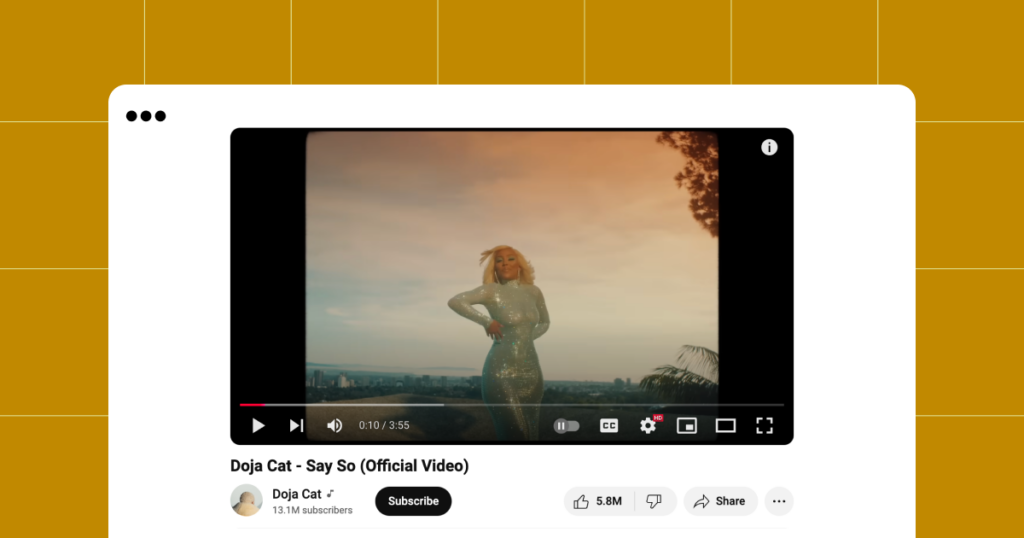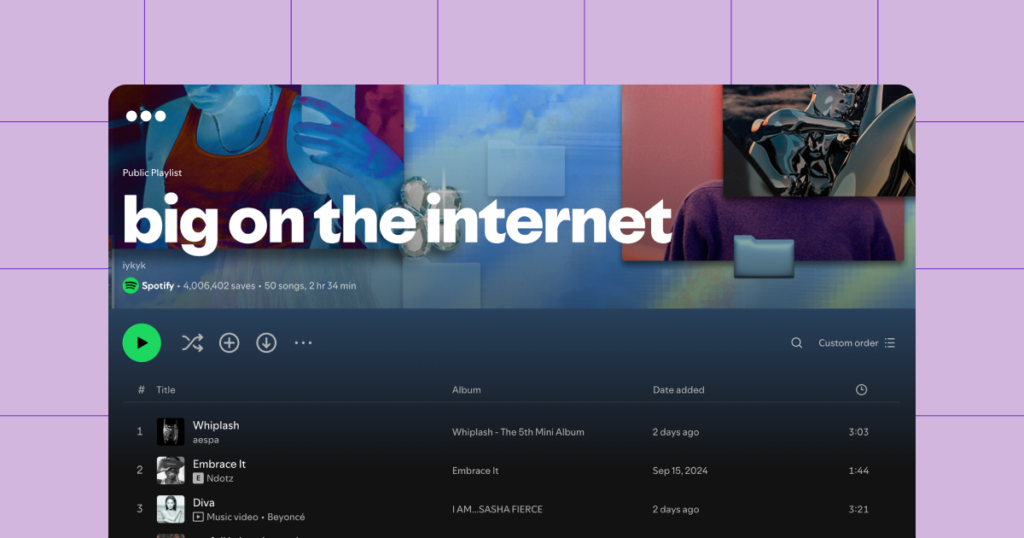You’ve experienced this a million times: that banger of a song is in everyone’s Stories and Reels on Instagram. But, you want to use that jam on your Instagram Story, too.
Adding music is important! If there’s one thing that universally bonds, it’s the power of a good tune that goes hard. And social media is a great way to discover new songs if you’re not a total music nerd who scours Apple Music or Spotify every week for interesting things to check out.
Consider these reasons why you might want to get on board with adding that Sabrina Carpenter or Metallica song to your Instagram Reel:
- Boosts Visibility and Reach: Instagram’s algorithm tends to favor content that incorporates trending elements, like popular music. (How many Eras songs have you heard on social media? A lot.) By using these tracks, creators have a better chance of appearing on the Explore page or in the Instagram Reels section, exposing their content to a broader audience. In short, trending music acts like a magnet, drawing in more eyeballs and increasing the likelihood of the video going viral. Anyone remember the summer smash — “The Devil is a Lie” by Tommy Richman? That was fueled by popping up in Instagram Reels and Instagram Stories all summer long.
- Enhances Viewer Engagement: Music sets the tone for a Reel and can evoke strong emotions or responses from social media viewers. Using a familiar or trending song can instantly capture attention and keep viewers watching longer, which tells Instagram’s algorithm to prioritize the content. A great beat or catchy tune makes the content more memorable and shareable. The name of the game is Instagram engagement, baby.
- Capitalizes on Trends and Challenges: Many Reels trends and challenges revolve around specific songs or audio clips. Jumping onto these trends by using the same music allows creators to participate in viral content themes, making their posts part of a larger conversation. This participation can lead to increased engagement, comments, and follows, as people often search for and watch content tied to specific trending songs.
- Creates a Sense of Relatability: Popular music often resonates with specific audiences and demographics. By using the right songs, creators can communicate more effectively with their target audience, conveying shared tastes or interests. This relatability helps build a stronger connection between the creator and their social media followers. (Anyone remember the Fleetwood Mac guy on the skateboard? He helped sell a lot of Ocean Spray. All through the power of Instagram music.)
- Increases Discoverability: When a creator uses a trending track, their Reel can show up on the song’s dedicated page. Users who browse by song will see all the content featuring that music, providing another avenue for discovery. It’s like being included in a playlist — viewers come for the music but might stay for the creator’s content.
As of 2024, Instagram has continued to make adjustments to how business and creator accounts access music. Here’s the most up-to-date method for getting trending music onto a creator account:
Getting Music on Instagram for Creator Accounts (2024)
- Switch to a Creator Account (if you haven’t already):
- Open Instagram profile and tap on the three horizontal lines in the upper-right corner.
- Select Settings and Privacy.
- Tap Account Type and Tools, then choose Switch to Creator Account.
- Follow the on-screen instructions to switch your account type.
- Explore the Music Library:
- Once you have a creator account, go to Stories or Reels and tap the Music icon.
- The music library should show a wide selection of songs, including popular and trending tracks.
- Check Your Music Access:
- If you’re still not seeing trending songs or popular artists, the issue might be related to copyright restrictions in your region or the account category settings. Go to Edit Profile and try switching your category to something broader, like Public Figure, Blogger, or Entrepreneur. This change can sometimes influence which tracks are accessible.
- Use Original Audio from Other Creators:
- You can also access trending music by using the “Original Audio” from other creators’ Reels. This option is great for reusing popular tracks that have been uploaded as “Original Audio” by other users.
- Explore Third-Party Tools:
- If your creator account still faces restrictions, consider using third-party apps like InShot or CapCut to add popular music to your videos outside Instagram. Then, upload the edited video as a Reel with the original sound muted, and manually credit the song in your caption.
- Use Creator Studio or Meta Business Suite:
- Some creators have reported more extensive access to music by managing their Instagram content through Meta Business Suite or Creator Studio. This can sometimes provide access to a broader music library when scheduling or posting directly through these tools.
These steps reflect the latest updates from Instagram in 2024. Given Instagram’s ever-evolving features and policies, it’s always a good idea to check for new options in the app’s Help Center or through the official Meta updates.
Social media has become an incredibly powerful platform for discovering and hearing new music to feature in your Instagram video post; good music just gets people hyped up. Here’s why you should consider dropping that new Spiritual Cramp jam in your Instagram Story.
1. Viral Sharing and Amplification
Social media platforms like Instagram make it incredibly easy for users to share music clips, videos, and playlists with their networks. A catchy song can go viral in hours as users repost, tag friends, and engage with the content. What used to require a big marketing push or radio play now happens organically as users spread the music across their feeds. A song used in an Instagram Story or an Instagram Reel can catapult an unknown artist into viral stardom, Chappell Roan, anyone? She’s got more than one popular song thanks to social media embracing her, and now, her festival appearances are worldwide events pushing the then-unknown into music icon territory — and fast.

2. Integration with Visual Content
On Instagram, music is often paired with visually compelling content — whether it’s a dance, a meme, or a creative short video. This gives new tracks a highly engaging context, making it more likely for users to remember and connect with the song they’ve seen in a creator’s Instagram Reel. The visual and auditory combination allows people to discover music in a way that feels immersive and fun, rather than just passively listening. Instagram users love showing off what they’re into, who they’re loving right now by dropping their must-hear tracks from their music library over their video content.
3. Algorithmic Discovery
Social media algorithms are designed to show users content they’ll likely enjoy based on their interactions. This means that as users engage with music-related content — whether it’s liking a dance challenge or following a musician’s account — the platform starts recommending similar songs or artists. This personalization helps users discover music tailored to their tastes, creating a highly effective, curated discovery process that record labels could only dream of before the social media age. Content creators are jumping on this trend, finding the right music that’ll make their video clip pop off throughout their followers’ Instagram feeds.

4. Music Challenges and Memes
Instagram has been instrumental in turning songs into memes or challenges. Songs like Lil Nas X’s Old Town Road or Doja Cat’s Say So gained massive popularity due to viral challenges that encouraged users to participate, dance, or create memes around the song. These challenges act as vehicles for music discovery, exposing millions to new tracks while adding layers of interaction and user-generated content. The right music can make a big impact with certain followers.
5. Direct Artist-to-Audience Connection
Artists can now share their music directly with fans through platforms like Instagram and Twitter, cutting out the traditional gatekeepers, because online content is now king. They can tease new tracks, post behind-the-scenes content, or go live to connect with their fanbase in real-time. This direct interaction builds a sense of community and connection between the artist and their audience, which can help generate buzz around new releases thanks to Instagram content.

6. Instant Access and Streaming
With integrated links to streaming platforms like Spotify and Apple Music, social media makes it easy for users to immediately listen to a song they discover. A listener can watch a music clip on Instagram, and with a single tap, access the full song on a streaming service, making the discovery-to-listening pipeline almost seamless.
Instagram influencers with large followings have become key players in music promotion via Instagram Reels. When influencers use new music in their content or endorse an artist, it introduces the track to potentially millions of their followers. This influencer-driven model has turned social media into a launchpad for up-and-coming musicians, helping them reach audiences they wouldn’t otherwise have access to. Pro tip: Don’t forget to make sure the song title is featured in the description; if so, this is a win-win for everyone’s Instagram engagement.

8. Community Engagement and Virality
Social media thrives on engagement — likes, comments, shares, and more. When users feel connected to a song or an artist, they become part of a community that helps push the music further. Whether it’s through creating their own content using a song or video clip, or sharing it with friends, the collaborative nature of social media turns music discovery into a communal experience, driving tracks up the charts through user participation.
Social media isn’t just a place to passively listen to music; it’s a dynamic environment where songs are discovered, shared, and amplified through communities, content, algorithms, and viral trends. Its interactive nature makes it one of the most powerful tools for people to hear new music today. Even though some of us do remember the power of MTV.